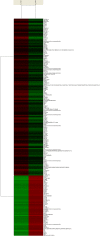RNAi targeting GPR4 influences HMEC-1 gene expression by microarray analysis
- PMID: 24753754
- PMCID: PMC3992399
RNAi targeting GPR4 influences HMEC-1 gene expression by microarray analysis
Abstract
G-protein coupled receptor 4 (GPR4) belongs to a protein family comprised of 3 closely related G protein-coupled receptors. Recent studies have shown that GPR4 plays important roles in angiogenesis, proton sensing, and regulating tumor cells as an oncogenic gene. How GPR4 conducts its functions? Rare has been known. In order to detect the genes related to GPR4, microarray technology was employed. GPR4 is highly expressed in human vascular endothelial cell HMEC-1. Small interfering RNA against GPR4 was used to knockdown GPR4 expression in HMEC-1. Then RNA from the GPR4 knockdown cells and control cells were analyzed through genome microarray. Microarray results shown that among the whole genes and expressed sequence tags, 447 differentially expressed genes were identified, containing 318 up-regulated genes and 129 down-regulated genes. These genes whose expression dramatically changed may be involved in the GPR4 functions. These genes were related to cell apoptosis, cytoskeleton and signal transduction, cell proliferation, differentiation and cell-cycle regulation, gene transcription and translation and cell material and energy metabolism.
Keywords: GPR4; RNAi; microarray.
Figures




References
-
- Seuwen K, Ludwig MG, Wolf RM. Receptors for protons or lipid messengers or both? J Recept Signal Transduct Res. 2006;26:599–610. - PubMed
-
- An S, Tsai C, Goetzl EJ. Cloning, sequencing and tissue distribution of two related G protein-coupled receptor candidates expressed prominently in human lung tissue. FEBS Lett. 1995;375:121–124. - PubMed
-
- Zhu K, Baudhuin LM, Hong G, Williams FS, Cristina KL, Kabarowski JH, Witte ON, Xu Y. Sphingosylphosphorylcholine and lysophosphatidylcholine are ligands for the G protein-coupled receptor GPR4. J Biol Chem. 2001;276:41325–41335. - PubMed
LinkOut - more resources
Full Text Sources
